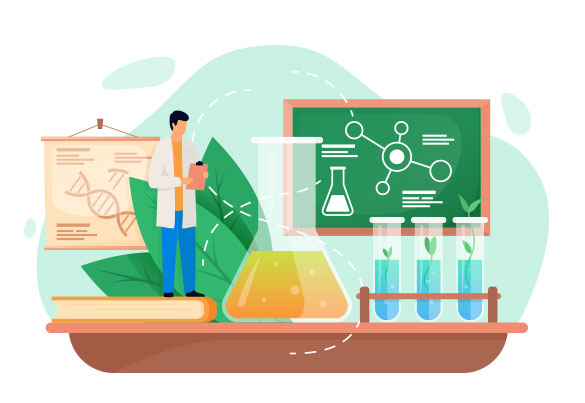DNA-encoded Library (DEL) Synthesis
The main purpose of DEL technology is to accelerate the speed of early drug development, such as lead identification. DEL technology perfectly combines combinatorial chemistry and molecular biology, and has been greatly promoted by the rapid development of high-throughput sequencing technology, making the screening of lead compounds faster and more efficient than ever. BOC Sciences has developed a complete set of DEL production process and quality control methods, which ensures the DELs are always constructed with higher efficiency and quality.
Principle of Synthesis Process
Each building block in the synthesis of a DNA-encoded chemical library is encoded by a unique double-stranded DNA segment (ie recognition). After each chemical reaction, the identity of the newly introduced building block is provided by the additional DNA fragments, which are connected to form a new DNA structure, and different building blocks are cross-combined and arranged.
 Figure 1. DNA-encoded chemical libraries design. (Clark, M. A.; et al. 2009)
Figure 1. DNA-encoded chemical libraries design. (Clark, M. A.; et al. 2009)
Our Services
To make it easier and better for researchers, BOC Sciences provides DEL library synthesis services in a competitive fashion. At present, we support mainly two approaches of constructing DNA-encoded library mainly including DNA encoding method and DNA template synthesis method:
- DNA encoding synthesis method
The DNA coding technique mainly applies the Split&Pool method in combinatorial chemistry to the production process. First, a set of specific DNA sequences (n) are chemically linked with small organic molecules, and these compounds with deoxyribonucleic acid are combined for the first time ('Pool') and evenly divided ('Split') Into a certain number of groups (m). Under similar conditions, the building block (m) of the second group is combined with the first group, and the modified-encoded oligonucleotide chain corresponding to the second group of compounds is introduced by enzymatic linkage before mixing them. The other group is the oligonucleotide encoding the second modification, and the enzyme is introduced before mixing. Repeat this several times (r) to form a (n x m) r-sized DNA-encoded library.
- DNA template synthesis method
DNA template synthesis is another way to build a DEL. The main advantage of this method is that it can construct a circular macromolecular compound structure of a 3D structure, which can break through the limitations of DNA coding method to form more types of DEL libraries. The main principle of this method is to connect a long single-stranded DNA sequence to the small molecule compound of the first group based on the principle of base complementarity of double-stranded DNA, and use the principle of base complementation in the subsequent process of merging and evenly dividing. Other groups of small molecules connected by a short single-stranded DNA connection are fixed in the corresponding DNA complementary region, and these compounds can be formed into a large circle of coding compounds in the final chemical reaction process.
Features of Our Synthesis Workflow
- BOC Sciences has established a complete process control and final product quality evaluation system
We use multiple quality control methods (UPLCMS, HPLC and electrophoresis) to monitor chemistry or ligation reaction during the process of DEL production.
We can evaluate the quality of the final product using quality control methods such as electrophoresis and quantification (by Qubit, OD, bioanalyzer and qPCR).
- In order to ensure the library quality, we have introduced an automatic synthesis platform for DNA-encoded library synthesis which supports the entire process of library synthesis. Our automated platform can accurately and efficiently process tens of thousands of reactions in parallel. From library design to product delivery, it only takes less than three months at the fastest.
- Our teams have completed the construction of more than one trillion DNA-encoding compounds based on more than 35,000 molecular building blocks.
- We have rich experience in independently developing and accumulating nearly a hundred DNA-compatible chemical reactions.
BOC Sciences provides professional, rapid and high-quality services of DNA-encoded library (DEL) synthesis at competitive prices for global customers. Personalized and customized services of DNA-encoded library (DEL) synthesis can satisfy any innovative scientific study demands. Our clients have direct access to our staff and prompt feedback to their inquiries. If you are interested in our services, please contact us immediately!
Reference
- Clark, M. A.; et al. Design, synthesis and selection of DNA-encoded small-molecule libraries. Nat. Chem. Biol. 2009. 5: 647-654.
